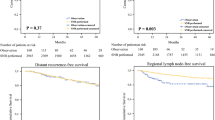Abstract
Background
Age-related outcomes have become increasingly common in evaluating patients with melanoma. For instance, as age increases, sentinel node (SN) nonidentification increases and SN positivity decreases. Furthermore, advanced age is a risk factor for in-transit disease. We hypothesized that increasing age is accompanied by alterations in lymphatic function, possibly explaining these findings.
Methods
Our center’s melanoma database was queried to identify patients who underwent successful sentinel node biopsy after lymphoscintigraphy. Records of those treated between 2000 and 2005 were reviewed for age, sex, drainage basin, intraoperative radioactivity, and SN pathology.
Results
The 858 patients had a mean age of 55 years; 59% were men. Mean radioactivity in the hottest SN was 5232 counts per second; 179 patients (21%) had SN metastases. SN count rates were significantly and inversely related to age (P < .001 by Pearson correlation, analysis of variance, and χ2 test). Mean counts per second were 6105, 5883, and 2720 for axillary, inguinal, and cervical basins, respectively (P < .01), and count rates in these basins were consistently lower with increasing age (neck and axilla, P < .001; groin, P = .060; Pearson correlation). Multivariate analysis confirmed an independent inverse association between age and count rates (P < .001), overall and within each primary tumor site.
Conclusions
Lymphatic function, as assessed by radiocolloid transit to and uptake within the SN, declines with age. Altered lymphatic function in older patients may modify metastatic patterns; knowledge of this may help clarify findings of reduced nodal positivity and increased in-transit disease in this population.


Similar content being viewed by others
References
Jemal A, Siegel R, Ward E, et al. Cancer statistics, 2008. CA Cancer J Clin. 2008;58:71–96.
Balch CM, Soong SJ, Gershenwald JE, et al. Prognostic factors analysis of 17,600 melanoma patients: validation of the American Joint Committee on Cancer melanoma staging system. J Clin Oncol. 2001;19:3622–34.
Sondak VK, Taylor JM, Sabel MS, et al. Mitotic rate and younger age are predictors of sentinel lymph node positivity: lessons learned from the generation of a probabilistic model. Ann Surg Oncol. 2004;11:247–58.
Chao C, Martin RC II, Ross MI, et al. Correlation between prognostic factors and increasing age in melanoma. Ann Surg Oncol. 2004;11:259–64.
Chakera AH, Friis E, Hesse U, et al. Factors of importance for scintigraphic non-visualisation of sentinel nodes in breast cancer. Eur J Nucl Med Mol Imaging. 2005;32:286–93.
Pawlik TM, Ross MI, Johnson MM, et al. Predictors and natural history of in-transit melanoma after sentinel lymphadenectomy. Ann Surg Oncol. 2005;12:587–96.
Morton DL, Wen DR, Wong JH, et al. Technical details of intraoperative lymphatic mapping for early stage melanoma. Arch Surg. 1992;127:392–9.
Faries MB, Bedrosian I, Reynolds C, et al. Active macromolecule uptake by lymph node antigen-presenting cells: a novel mechanism in determining sentinel lymph node status. Ann Surg Oncol. 2000;7:98–105.
Morton DL, Thompson JF, Essner R, et al. Validation of the accuracy of intraoperative lymphatic mapping and sentinel lymphadenectomy for early-stage melanoma: a multicenter trial. Multicenter Selective Lymphadenectomy Trial Group. Ann Surg. 1999;230:453–63.
Mahieu-Renard L, Cammilleri S, Giorgi R, et al. Slow dynamics of lymphoscintigraphic mapping is associated to the negativity of the sentinel node in melanoma patients. Ann Surg Oncol. 2008;15:2878–86.
Bleicher RJ, Essner R, Foshag LJ, Wanek LA, Morton DL. Role of sentinel lymphadenectomy in thin invasive cutaneous melanomas. J Clin Oncol. 2003;21:1326–31.
Birdwell RL, Smith KL, Betts BJ, et al. Breast cancer: variables affecting sentinel lymph node visualization at preoperative lymphoscintigraphy. Radiology. 2001;220:47–53.
Haigh PI, Hansen NM, Giuliano AE, et al. Factors affecting sentinel node localization during preoperative breast lymphoscintigraphy. J Nucl Med. 2000;41:1682–8.
Gasheva OY, Knippa K, Nepiushchikh ZV, Muthuchamy M, Gashev AA. Age-related alterations of active pumping mechanisms in rat thoracic duct. Microcirculation. 2007;14:827–39.
Yoon YS, Murayama T, Gravereaux E, et al. VEGF-C gene therapy augments postnatal lymphangiogenesis and ameliorates secondary lymphedema. J Clin Invest. 2003;111:717–25.
Kennedy C, Bastiaens MT, Bajdik CD, et al. Effect of smoking and sun on the aging skin. J Invest Dermatol. 2003;120:548–54.
Tsuchida Y, Fukuda O, Nakano M. The effect of aging on skin blood flow in human. In: Mesmer K, Kubler WM, editors. Sixth World Congress for Microcirculation. Bologna: Monduzzi Editore; 1996.
Ryan TJ, Curi S. The cutaneous adipose tissue.. Philadelphia: Lippincott; 1989.
Fenske NA, Lober CW. Structural and functional changes of normal aging skin. J Am Acad Dermatol. 1986;15(4 Pt 1):571–85.
Luscieti P, Hubschmid T, Cottier H, Hess MW, Sobin LH. Human lymph node morphology as a function of age and site. J Clin Pathol. 1980;33:454–61.
Sundar SS, Ganesan TS. Role of lymphangiogenesis in cancer. J Clin Oncol. 2007;25:4298–307.
Cochran AJ, Huang RR, Lee J, et al. Tumour-induced immune modulation of sentinel lymph nodes. Nat Rev Immunol. 2006;6:659–70.
Uren RF, Howman-Giles RB, Thompson JF, Roberts J, Bernard E. Variability of cutaneous lymphatic flow rates in melanoma patients. Melanoma Res. 1998;8:279–82.
Pan WR, Suami H, Taylor GI. Lymphatic drainage of the superficial tissues of the head and neck: anatomical study and clinical implications. Plast Reconstr Surg. 2008;121:1614–24.
Acknowledgments
Supported by grant CA29605 from the National Cancer Institute and by funding from the Wayne and Gladys Valley Foundation (Oakland, CA), the Family of Robert Novick (Los Angeles, CA), the Ruth and Martin H. Weil Fund (Los Angeles, CA), and the Wrather Family Foundation (Los Alamos, CA). Dr. Conway is the Carolyn Dirks Fellow.
Author information
Authors and Affiliations
Corresponding author
Rights and permissions
About this article
Cite this article
Conway, W.C., Faries, M.B., Nicholl, M.B. et al. Age-Related Lymphatic Dysfunction in Melanoma Patients. Ann Surg Oncol 16, 1548–1552 (2009). https://doi.org/10.1245/s10434-009-0420-x
Received:
Revised:
Accepted:
Published:
Issue Date:
DOI: https://doi.org/10.1245/s10434-009-0420-x




